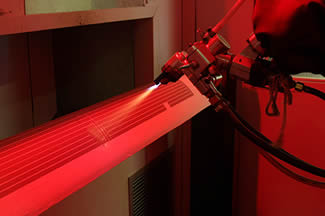|
GKN Aerospace has recently completed the coordination and lead of a nine member, European Union (EU)-funded project, called ‘ON-WINGS’. This project has successfully developed new optical ice monitoring technology that could enable fully automated in-flight ice protection for the first time.
The ‘ON-WINGS’ project has: Designed and built a new optical ice detection sensor head; Developed technology that analyses data from this sensor head to precisely monitor ice accumulation; Integrated this equipment as the primary sensor to directly control an electro-thermal ice protection system; Completed ground tests using the GKN Aerospace icing research tunnel facility in the UK.
Extensive testing of the ice detector culminated in flight trial tests in Poland in February 2013
on board an AgustaWestland (PZL) helicopter.
| Whereas most current ice sensors
are sited remotely from any icing surfaces, the ON-WINGS ice sensor
head can be flush mounted into any aerofoil, whether wing, rotor-blade or
engine nacelle, and so can directly measure ice as it develops on any
aerofoil surface. The new sensor head uses optical fibres to emit light
into any ice and collect and measure the light returned. It can
directly replace existing ice detection probes or be integrated
into any vulnerable surface on the aircraft or
aero-engine. |
|
 |
| GKN Aerospace electro-thermal ice protection heater mat - flame spray process. |
Collected data is analysed using new data measurement technology which can determine the
precise type, severity, thickness and location of any ice as it develops.
This precision monitoring technology can then send detailed icing information directly to the aircraft’s ice protection system (IPS) so functioning as a primary sensor and providing fully automated, fine-control of a zoned and highly controllable ice protection function for the first time.
Rich Oldfield, Technical Director, GKN Aerospace explains: “The ON-WINGS project results have huge potential across aviation. Improving the efficiency of ice protection will have positive consequences for operators of all types of aircraft. More efficient, controlled ice protection will lower fuel consumption, increase airframe or aero-engine performance and endurance and lower maintenance needs - as well as reducing critical carbon emissions. All these are vital factors for operators and users of aircraft worldwide.”
The
ON-WINGS project began in October, 2009 and was completed in December, 2012. Consortium members were: GKN Aerospace, University of Ioannina, University of Athens, AOS Technology, Sensor Highway Ltd (a Schlumberger company), TWT GmbH, ESW GmbH, Airbus S.A.S and Agusta Westland
(PZL).
|